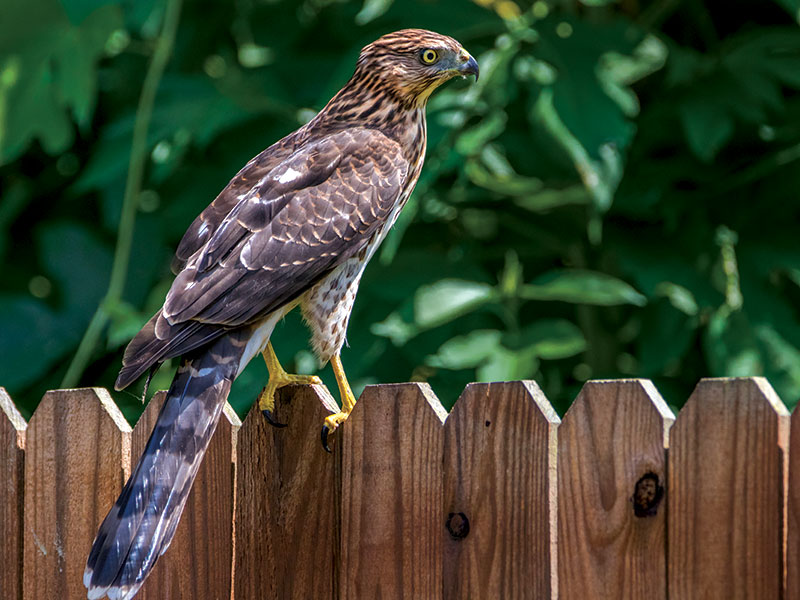
Predators are a huge concern for chickens, especially those raised in backyard coops that aren’t as secure as they should be. Whether you raise two backyard chickens or thousands in a commercial setting, take precautions to mitigate the birds’ exposure to predators. It’s far easier to deter predators before you have a problem than to keep predators away from a known food source.
First Lines of Defense Against Predators
Your coop design and management sets the foundation for safe chickens. Your goal is to make your chickens—and eggs, if you have layers—as difficult to get as possible.
Fencing
Your coop needs a sturdy fence to guard chickens against predators from the air such as raptors as well as predators on the ground such as raccoons. For fencing material, we recommend using 1â„4-inch hardware cloth as opposed to chicken wire because of its superior strength. Bury the hardware cloth at least 5 to 6 inches in the ground and cover with rocks or pebbles. (Rodents don’t like to dig through loose rocks.) Walk the fence daily to inspect for holes.
Good Husbandry
Part of denying predators access to your flock is good husbandry. If you have layers, collect your eggs frequently (at least once daily) so the coop has fewer eggs to attract predators.
Because many predators are active during the evening, make sure your chickens are safely enclosed in their coop at night. If some chickens like to perch outside of the coop, double check those areas each night to make sure no bird is locked out. Avoid leaving out feed that entices wildlife overnight. Store all feed in sturdy, airtight containers.
Even if feed is not a lure, mice and rats that show up lead predators to your flock. To reduce rats and mice, minimize harborage as well as any food waste or garden food near your coops.
During the day, provide shade structures so your chickens can hide from aerial predators such as hawks. You can also remove potential perch sites for birds of prey—such as trees—that are near your flock.
Another key aspect of management is record keeping. Recording what wildlife you see and the number of chickens you own helps you identify when you have a predatory problem.
What’s Eating My Chickens?
The first step in predator control is identifying what kind of predators you have: The type of deterrent you employ depends on the predators.
A vast number of predators view chickens as a delicious snack; these include dogs, coyotes, raccoons, snakes, possums, stray cats, mountain lions and owls. If you work hard to deter hawks, yet raccoons are your biggest predator, your hard work will be for nothing.
Investigate the Area
The easiest way to get a basic idea of predator types is observation and asking neighbors what animals they’ve seen. If you’ve spotted a hawk, and a neighbor mentions hearing coyote calls and seeing footprints, start investing time in deterrents for those species.
If a predator has targeted your flock but you’re not sure which type it is, here are a few patterns of predation that can help you identify the culprit.
- Missing Adult Birds: coyotes, bobcats, foxes, dogs or birds of prey
- Missing Heads/Limbs: raccoons
- Missing Eggs: opossums, skunks, rats, cats, snakes, raccoons, blue jays or crows
- Missing Chicks: opossums, skunks, rats, cats, snakes or birds of prey
- Bloody/Torn Carcasses (Uneaten): raccoons, weasels and their relatives, or dogs
- Birds with Missing Feathers/Abrasions: cats
- Lacerations Near Cloaca / Intestinal Evisceration: weasels and relatives
- Bites All Over: dogs
- Wounds on Breasts/Legs of Young Birds: opossums
- Bites on Hocks of Young Birds: rats

You can also look for tracks of predators for possible identification.
While these approaches aren’t perfect, they can provide initial clues as to what is lurking around your property. For a little money (about $100), you can also purchase motion-sensing cameras to monitor wildlife around the clock. If you can identify predators, you can understand their abilities and targets.
Deterrents for Predators
The market for predator deterrents is huge because, unfortunately, no single method works for all predators. You often need to employ multiple deterrents and vary your methods every now and then. Predators are cunning and are not dissuaded by the same deterrent for long.
As noted previously, minimizing harborage and food waste or backyard crops near coops helps deter scavenging predators such as rats, raccoons and opossums. Adding a motion-sensor light, predator light or water sprinkler can also help deter predators.
Additional methods for birds of prey include reflective deterrents, dummy predator birds and scarecrows.
Dummy coyote cutouts can be effective as long as they are moved frequently. This is also true of shiny/noisy tape, which you can hang from your coop roof and fence lines.
Many other deterrents (such as chemical or pheromone repellents) are available, with limited amounts of success.
By optimizing husbandry practices including installing proper fencing, controlling harborage and minimizing loose feed in coops, you can help ensure safe enclosures to deter predators and prevent your chickens from becoming snacks. Consider additional deterrents only after you’ve completed these basics.
With all methods, vary the techniques and move the location of physical deterrents often. Finally, if you have a predator problem, contact your local USDA Wildlife Services branch, which can assist with some predator relocation and control.
Anny Huang is a research associate at the UC Davis School of Veterinary Medicine. Maurice Pitesky is a faculty member and veterinarian at the UC Davis School of Veterinary Medicine-Cooperative Extension.




